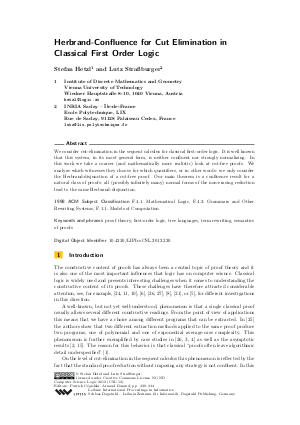Herbrand-Confluence for Cut Elimination in Classical First Order Logic
Authors Stefan Hetzl, Lutz Straßburger
-
Part of:
Volume:
Computer Science Logic (CSL'12) - 26th International Workshop/21st Annual Conference of the EACSL (CSL 2012)
Part of: Series: Leibniz International Proceedings in Informatics (LIPIcs)
Part of: Conference: Computer Science Logic (CSL) - License:
 Creative Commons Attribution-NonCommercial-NoDerivs 3.0 Unported license
Creative Commons Attribution-NonCommercial-NoDerivs 3.0 Unported license
- Publication Date: 2012-09-03
File

PDF
LIPIcs.CSL.2012.320.pdf
- Filesize: 0.52 MB
- 15 pages
Document Identifiers
Subject Classification
Keywords
- proof theory
- first-order logic
- tree languages
- term rewriting
- semantics of proofs
Metrics
- Access Statistics
-
Total Accesses (updated on a weekly basis)
0PDF Downloads0Metadata Views
Abstract
We consider cut-elimination in the sequent calculus for classical first-order logic. It is well known that this system, in its most general form, is neither confluent nor strongly normalizing. In this work we take a coarser (and mathematically more realistic) look at cut-free proofs. We analyze which witnesses they choose for which quantifiers, or in other words: we only consider the Herbrand-disjunction of a cut-free proof. Our main theorem is a confluence result for a natural class of proofs: all (possibly infinitely many) normal forms of the non-erasing reduction lead to the same Herbrand-disjunction.
Cite As Get BibTex
Stefan Hetzl and Lutz Straßburger. Herbrand-Confluence for Cut Elimination in Classical First Order Logic. In Computer Science Logic (CSL'12) - 26th International Workshop/21st Annual Conference of the EACSL. Leibniz International Proceedings in Informatics (LIPIcs), Volume 16, pp. 320-334, Schloss Dagstuhl – Leibniz-Zentrum für Informatik (2012)
https://doi.org/10.4230/LIPIcs.CSL.2012.320
BibTex
@InProceedings{hetzl_et_al:LIPIcs.CSL.2012.320,
author = {Hetzl, Stefan and Stra{\ss}burger, Lutz},
title = {{Herbrand-Confluence for Cut Elimination in Classical First Order Logic}},
booktitle = {Computer Science Logic (CSL'12) - 26th International Workshop/21st Annual Conference of the EACSL},
pages = {320--334},
series = {Leibniz International Proceedings in Informatics (LIPIcs)},
ISBN = {978-3-939897-42-2},
ISSN = {1868-8969},
year = {2012},
volume = {16},
editor = {C\'{e}gielski, Patrick and Durand, Arnaud},
publisher = {Schloss Dagstuhl -- Leibniz-Zentrum f{\"u}r Informatik},
address = {Dagstuhl, Germany},
URL = {https://drops.dagstuhl.de/entities/document/10.4230/LIPIcs.CSL.2012.320},
URN = {urn:nbn:de:0030-drops-36815},
doi = {10.4230/LIPIcs.CSL.2012.320},
annote = {Keywords: proof theory, first-order logic, tree languages, term rewriting, semantics of proofs}
}
